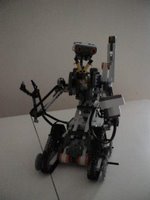Fellow MDPer Daniele Benedettelli has been working quietly on a well-known figure from the 80's... below are some questions I presented to Daniele with responses (in red):
1. Why did you choose to build a NXT version of Johnny 5?
Since I first published my RCX J5 model on my webpage, I have received literally dozens of e-mails from people asking me for instructions; a few even have asked me to build (kits) replicas to sell! If you take a look at the J5, with rare parts and custom-made electronics, you can realize the cost would be quite high! So, encouraged by such a positive feedback, I proposed to the MDP administrator to develop a NXT version of Johnny, showing off the great power of new Mindstorms line, with servos, Ultrasonic sensors and sound playback!
2. Where did you start? With the base? The head?
 I started studying the J5 real dimensions and proportions on photos found on the Internet, and with the help of the www.input-inc.com team. I made a CAD design of J5 to plan out the JohnNXT (this could be the name) dimensions in Lego units. Since AlphaRex photos were released, many people have noticed a likeness between the J5 head and the new Ultrasonic Sensor. I got the solution to use the US sensor as the head, adding parts to make it bigger: now, the actual challenge is to make eyelids! I started with the base, using 40z gears and turntables as sprockets (note that the treads in the photos are not yet complete). Two NXT bricks fit perfectly on the base and on the lower abdomen (still missing in the photos).
I started studying the J5 real dimensions and proportions on photos found on the Internet, and with the help of the www.input-inc.com team. I made a CAD design of J5 to plan out the JohnNXT (this could be the name) dimensions in Lego units. Since AlphaRex photos were released, many people have noticed a likeness between the J5 head and the new Ultrasonic Sensor. I got the solution to use the US sensor as the head, adding parts to make it bigger: now, the actual challenge is to make eyelids! I started with the base, using 40z gears and turntables as sprockets (note that the treads in the photos are not yet complete). Two NXT bricks fit perfectly on the base and on the lower abdomen (still missing in the photos).3. What do you think its overall functionality will be when you are done?
 Two motors will drive the treads and JNXT will go! A motor in the lower column will raise up the torso completely (a parallel kinematics structure keeps the head vertical). In the upper body, a motor will turn the head, another will move the laser, and another will move the arms and hands as in my older version. When I get another NXT brick I'll program JohnNXT to do hand following (US sensor), line following (base built-in light sensor), and then to dance, grab objects and use stereo sound ears to follow noises.
Two motors will drive the treads and JNXT will go! A motor in the lower column will raise up the torso completely (a parallel kinematics structure keeps the head vertical). In the upper body, a motor will turn the head, another will move the laser, and another will move the arms and hands as in my older version. When I get another NXT brick I'll program JohnNXT to do hand following (US sensor), line following (base built-in light sensor), and then to dance, grab objects and use stereo sound ears to follow noises.4. Will it have recordings of Johnny 5 that it will play through its speakers?
If NXT memory will be enough, one of main features of this NXT Johnny 5 will be speech!!!!!
-----------
Many thanks to Daniele for providing the feedback... please continue to check the website for updates, videos, new images, etc. The images and level of detail that Daniele has provided is amazing and I'm looking forward to seeing more of the JNXT!